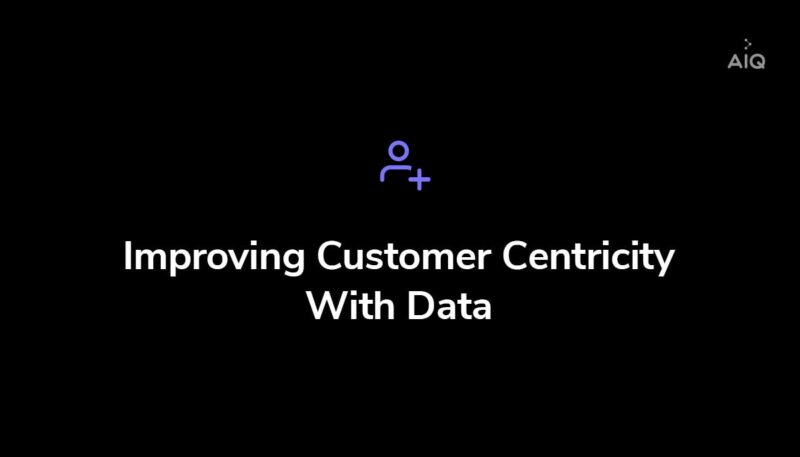Why Data Should be In the Center of Your Customer Centric Strategy

I placed my first order on Amazon.com December 11th, 1998. It was a book. That’s pretty much all Amazon sold back then. But back then, Jeff Bezos had already set the mission that still drives the company today: to become “Earth’s most customer centric company.”
That mission has catapulted Amazon to the rarefied air of being one of the first and few companies to exceed $1 trillion in market capitalization.
Along the way, Amazon has disrupted dozens of business models and transformed many industries. And it has set the gold standard for customer centricity. Even in industries Amazon doesn’t play in, the bar for customer experiences and customer interactions is set by Amazon. If your bank’s mobile app—or your insurance company’s customer dashboard, or your streaming service’s billing policy—isn’t up to snuff, it’s likely because you’ve failed to meet the customer expectations set by the likes of Amazon.
Today, of course, Amazon isn’t the only company setting expectations for customer centricity. Take your pick from across multiple industries: USAA in insurance, Citizens in consumer banking, Netflix in streaming media, or one of my personal favorites, Trader Joe’s in food.
What is Customer Centricity?
Customer centricity is putting the customer at the center of everything you do as a brand and as a business. When it’s done successfully, your brand will earn the lasting trust and loyalty of your customers.
They’ll go from typical customer to becoming brand advocates. Driving positive word of mouth and carrying your brand in ways you never expected—all resulting in growth, profitability, making your company a better place to work, and freeing up more resources to reinvest in serving your customers even better. Leading to a lasting competitive advantage.
I know when I interact with a brand, and the offerings feel like they’re for me, the service team feels like they’re there for me, the business appreciates my relationship with them, and it’s a pleasant, helpful experience—my loyalty is cemented. And I tell lots of friends.
The Importance of Customer Centricity
73% of consumers say that a single extraordinary experience with a brand (like some of the ones I mentioned above) raises their expectations for all the other brands they interact with. And brands that are able to create the right types of experiences—helpful and tailored to the individual—see a whopping 20% lift in business impact.
In multiple research studies, a positive CSAT score—which has emerged as a reliable barometer of customer centricity and customer experience (CX) success—has proved to be correlated to higher shareholder value and business profitability.
This is why customer centricity has become so important the driving force for so many digital transformations across forward thinking companies who seek to compete and win in the 21st century and beyond.
9 Fundamentals for Unlocking Great Customer Experiences
Across nearly every industry I work with in my role at ActionIQ—including banks, retail, CPG, travel and hospitality, technology, media and more—I see a fairly consistent set of foundational elements every company can focus on to unlock great customer experiences.
First, every company has to overcome some roadblocks: the first and most difficult of which is harnessing your customer data. Then, you’ll lay out the elements of your foundation for better customer experiences. Lastly, you’ll need to transform your organization to becoming truly customer centric.
Overcoming roadblocks to becoming customer centric
- Data silos. Most organizations’ customer data is spread across dozens of systems, each containing only a fragment of the picture of overall customer behavior.
- Departmental silos. Teams within the company that touch the customer aren’t set up to collaborate with each other. Acquisition, sales, CRM, service, web vs. in-person — each operates in its own walled garden resulting in a disjointed experience for the customer.
- Line of business KPIs. The KPIs that drive each team in the organization are aligned around that individual department’s goals. Instead of rolling up to the customer, they simply roll up to the success of the e-commerce site, or or the conversion rate on ads. There’s no holistic link to the quality of the customer experience.
Creating a technology foundation for better customer experiences
- Mastering your customer data. By unifying your customer data and creating a single, comprehensive view of each customer, you’ll gain powerful insights and be able to use your data to deploy breakthrough customer experiences.
- Deploying technology that empowers. Your customer data also needs to be democratized—so the businesspeople who conceive, manage and activate customer experiences can directly get their hands on the data and tools to make it all happen effectively.
- Focusing on the journey. Your tech shouldn’t just comprehend individual experiences. It must play a key role in understanding, designing and managing the entire customer journey from awareness to loyalty and everything in between.
To learn more about the tech that powers customer centricity, read the eBook The Modern Customer Experience Stack.
Building a Customer Centric Organization
- Align your goals and outcomes. To get your whole org on board for your customer centric transformation, you must first set clear goals backed by a business case. Then, you’ll secure executive sponsorship, lay out a roadmap and define success. Finally, with the help of your execs, you’ll align your entire organization around achieving it.
- Map out the jobs to be done. To achieve customer centricity, your company will have to work in ways it never has before. By defining all the new jobs to be done, you can identify your gaps in talent, and look to fill them through hiring, consultants or vendor partnerships.
- Evaluate your organizational maturity. Most organizations start out with a channel-aligned structure that isn’t ideal for centering around the customer. As you achieve early wins, you can begin to transition your organization to aligning around the customer journey, and then ultimately around the customer themselves
To learn more about transforming your organization for true customer centricity, read the eBook Change Management Best Practices.
4 Important KPIs for Measuring Customer Centricity Success
An old boss of mine once told me “you measure what you treasure.” Having a strong data foundation underpinning your customer centric strategy makes it a lot easier to do so. If your organization is serious about making the transformation to “treasuring” customer centricity, then consider promoting metrics such as these to becoming North Star KPIs for your customer experience analytics and performance management:
- Net promoter score (NPS) — NPS is a rating of how likely your customer is to recommend your company, product or service to a friend, family member or colleague. NPS is so powerful because it’s a measure of the customer’s entire experience with your brand. It also correlates directly with your customer’s likelihood of repurchasing—as well as your company’s revenue growth relative to competitors
- Customer satisfaction (CSAT) — CSAT is a rating of a customer’s individual experience with your brand. We most commonly experience this type of survey after customer support interaction, but CSAT can be used to measure any individual experience. I often see pop-ups asking me to rate a particular experience on a website. I’ve also seen “good / bad” buttons I can press walking out of a store to rate my visit. CSAT is important for helping your brand improve each of the individual experiences that make up the whole.
- Customer effort score (CES) — A big part of delivering great experiences is making it easy and helpful for customers to interact with your brand. CES is a measure of how easy it was for the customer to get something done. Like getting onboarded to use your software, making an insurance claim, completing a return or exchange, or scheduling service.
- Customer lifetime value (CLV) — CLV is the total revenue a single customer spends with your business over the entire span of their relationship with your brand. One of your key business outcomes from greater customer centricity and better customer experiences should be an increase in CLV. Read more on why CLV matters more than ever.
Putting metrics such as these at the center of your weekly, monthly, quarterly and annual business reviews will help keep your entire organization aligned around the customer, and help quantify the business performance improvements that will result from your customer centric strategy.
Taking the Next Step Towards Customer Centricity
Brands like Amazon, Netflix and others have done incredibly innovative and forward thinking things to put the customer at the center of everything they do. But customer centricity is no longer something exclusive to the fastest growing cutting edge brands. Modern tech and modern best practices are here to aid the transformation and enablement of every enterprise that believes in the customer-centric mission. If you’d like to learn more about how ActionIQ can help, contact ActionIQ today.





